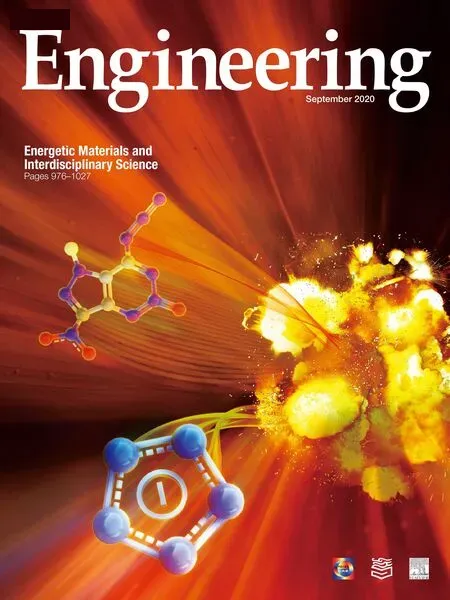Energetic Materials: Novel Syntheses and Diagnostics
Sheng-Nin Luo, Michel Gozin
a School of Materials Science and Engineering, Southwest Jiaotong University, Chengdu 610031, China
b School of Chemistry, Faculty of Exact Sciences, Tel Aviv University, Tel Aviv 69978, Israel
This special issue of Engineering comprises seven papers, contributed by experts from China, the United States, and the United Kingdom. The topics cover the synthesis and characterization of energetic materials,their energetic properties and combustion performances,ultrahigh pressure behavior,and diagnostic experimental techniques. The majority of the articles in this special issue report on the synthesis of novel energetic materials via chemical,physical,and ultrahigh pressure techniques,owing to its perpetual importance in the field of energetic materials. Thermomechanical,physical, and chemical processes that occur in energetic materials during manufacturing and processing or under the influence of external stimuli, such as shock compression, are inherently multiscale in nature. Understanding the structure-loading-property relations of energetic materials calls for temporally and spatially resolved diagnostics; research on diagnostics has long lagged behind that on synthesis. A review article is thus dedicated to novel diagnostics.
Mao et al.(this issue)address singly-bonded polymeric nitrogen and atomic metallic hydrogen from the high-pressure perspective,which are generally regarded as the ultimate energetic materials.Their syntheses normally require ultrahigh pressures of several hundred gigapascals; this prohibits the direct application of such materials. However, research on their stability, metastability, and fundamental properties are valuable for the fabrication of extreme energetic materials through alternative synthetic routes.
Carbon- and hydrogen-free pentazolate anion can release a large amount of energy upon decomposing into nitrogen gas. Lin et al.(this issue)present their perspective on the cyclopentazolate anion cyclo-N5-.Anhydrous metallic pentazolates show great promise as green, non-toxic, high-energy primary explosives. Hydrazine pentazolate and hydroxylamine pentazolate with nitrogen contents of approximately 95%are non-metallic pentazolates with the best performance and application potential.Efficient synthesis of pentazole and functional group-modified pentazolate compounds is a key direction in pentazole chemistry. The review by Wozniak and Piercey (this issue) provides a consolidated report on cyclo-N5-with a focus on pentazoles as energetic materials and on their experimental synthesis, including historical significance,precursors,synthetic routes,stability-affecting factors,energetic performances of compounds containing cyclo-N5-, and perspective on future experimental research in this direction. The perspective and review are useful for research on cyclo-N5-as an environmentally friendly next-generation explosive.
The development of advanced high-energy materials has been the most important issue in the field of energetic materials; it can be conducted at different levels. Feng et al. (this issue) report a promising fused-ring energetic material with an unusual twodimensional (2D) layered crystal structure, 4-nitro-7-azidopyrazol-[3,4-d][1,2,3]-triazine-2-oxide (NAPTO), demonstrating remarkably high energy content,low sensitivity,and high thermal decomposition temperature. A key factor in reducing sensitivity is the 2D layered structure which mitigates the external stimulation via interlayer motion.Shang et al.(this issue)synthesized two new metal-free hexagonal perovskite compounds, (H2dabco)[B(ClO4)3](H2dabco2+= 1,4-diazabicyclo[2.2.2]octane-1,4-diium) via an easy scale-up synthetic route, with NH3OH+/NH2NH3+as the B-site cations. These materials exhibit a high crystal density, a positive enthalpy of formation,high detonation performance,and excellent thermal stability.
Chen et al. (this issue) report a new group of energetic metastable intermixed composites (MICs) fabricated via spray granulation. These MICs are composed of aluminum as fuel, and ammonium perchlorate (AP) and polyvinylidene fluoride (PVDF)as co-oxidizers. The inclusion of graphene oxide (GO) increases the solid-state reaction rate of Al@AP/PVDF with improved thermal stability. Al@AP/PVDF-GO exhibits better interfacial contact and particle distribution, which results in a faster heat transfer rate,reduced agglomeration of nano-Al particles and an increased combustion reaction rate. This work demonstrates a new strategy to improve energy release rate and combustion efficiency of Al-based MICs.
Finally,Zhang et al.(this issue)present a timely review of novel diagnostics that are either emerging or have existed but have rarely been applied to energetic materials, including X-ray imaging/diffraction/scattering,coherent X-ray diffraction imaging,terahertz and optical absorption/emission spectroscopy, and laserbased velocity/displacement interferometry, across multiple temporal and spatial scales. The targeted scientific questions and engineering problems involve defect, strength, deformation, hot spot, phase change, reaction, and shock or thermal sensitivity.Basic principles of measurement and data analysis,and illustrative examples are presented. Such diagnostic tools are particularly useful for in situ characterization of the performance of energetic materials, revealing chemical-physical-mechanical mechanisms,establishing the structure-loading-property relations,and providing a guide to the synthesis and processing of energetic materials.
- Engineering的其它文章
- Laws of 4D Printing
- Novel X-Ray and Optical Diagnostics for Studying Energetic Materials:A Review
- Review of the Current Synthesis and Properties of Energetic Pentazolate and Derivatives Thereof
- Extreme Energetic Materials at Ultrahigh Pressures
- Hybrid Rice
- Pentazolate Anion Cyclo-N5-: Development of a New Energetic Material

